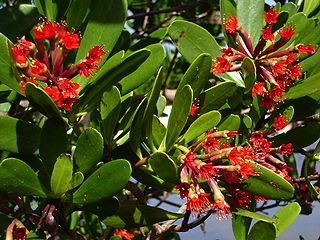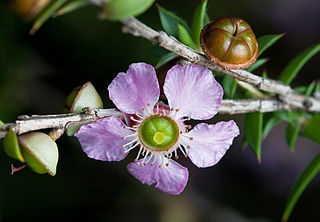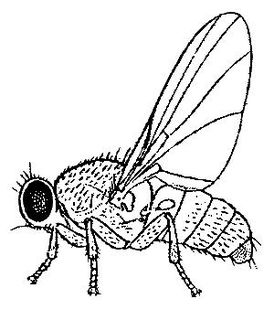
The Myrtales are an order of flowering plants placed as a sister to the eurosids II clade as of the publishing of the Eucalyptus grandis genome in June 2014.
Eucalypt is a descriptive name for woody plants with capsule fruiting bodies belonging to seven closely related genera found across Australasia: Eucalyptus, Corymbia, Angophora, Stockwellia, Allosyncarpia, Eucalyptopsis and Arillastrum.

Leptospermum scoparium, commonly called mānuka, manuka, manuka myrtle, New Zealand teatree, broom tea-tree, or just tea tree, is a species of flowering plant in the myrtle family Myrtaceae, native to south-east Australia and New Zealand.

Myrtaceae or the myrtle family is a family of dicotyledonous plants placed within the order Myrtales. Myrtle, pohutukawa, bay rum tree, clove, guava, acca (feijoa), allspice, and eucalyptus are some notable members of this group. All species are woody, contain essential oils, and have flower parts in multiples of four or five. The leaves are evergreen, alternate to mostly opposite, simple, and usually entire. The flowers have a base number of five petals, though in several genera the petals are minute or absent. The stamens are usually very conspicuous, brightly coloured and numerous.

Leptospermum is a genus of shrubs and small trees in the myrtle family Myrtaceae commonly known as tea trees, although this name is sometimes also used for some species of Melaleuca. Most species are endemic to Australia, with the greatest diversity in the south of the continent, but some are native to other parts of the world, including New Zealand and Southeast Asia. Leptospermums all have five conspicuous petals and five groups of stamens which alternate with the petals. There is a single style in the centre of the flower and the fruit is a woody capsule.

Metrosideros is a genus of approximately 60 trees, shrubs, and vines mostly found in the Pacific region in the family Myrtaceae. Most of the tree forms are small, but some are exceptionally large, the New Zealand species in particular. The name derives from the Ancient Greek metra or "heartwood" and sideron or "iron". Perhaps the best-known species are the pōhutukawa, northern rātā, and southern rātā of New Zealand, and ʻōhiʻa lehua,, from the Hawaiian Islands.

Syzygium is a genus of flowering plants that belongs to the myrtle family, Myrtaceae. The genus comprises about 1200 species, and has a native range that extends from Africa and Madagascar through southern Asia east through the Pacific. Its highest levels of diversity occur from Malaysia to northeastern Australia, where many species are very poorly known and many more have not been described taxonomically.

Backhousia is a genus of thirteen currently known species of flowering plants in the family Myrtaceae. All the currently known species are endemic to Australia in the rainforests and seasonally dry forests of Queensland, New South Wales and Western Australia.

Homoranthus is a genus of about thirty species of plants in the myrtle family Myrtaceae and all are endemic to Australia. Plants in this genus share similarities with those in both Darwinia and Verticordia. They are shrubs with their leaves arranged in opposite pairs and with flowers appearing either singly or in small groups, usually in upper leaf axils. They are found in Queensland, New South Wales and South Australia. The genus was first described in 1836. None of the species is common nor are they well-known in horticulture.

The Mycosphaerellaceae are a family of sac fungi. They affect many common plants, such as eucalyptus, the myrtle family, and the Proteaceae. They have a widespread distribution.
Curitiba is a monotypic genus of plant in family Myrtaceae, endemic to Brazil. The only species in the genus, Curitiba prismatica, was originally described as Eugenia prismatica by D.Legrand in 1969 and moved to its own genus by Andrew M. Salywon and Leslie Roger Landrum in 2007.

Pleurocalyptus is a group of shrubs and small trees in the family Myrtaceae, first described as a genus in 1868. The entire genus is endemic to New Caledonia. It is closely related to Xanthostemon.
Purpureostemon is a genus of plant in the myrtle family Myrtaceae described as a genus in 1939. There is only one known species, Purpureostemon ciliatus, endemic to New Caledonia. Purpureostemon is related to Xanthostemon.

Xanthostemoneae is a tribe in the plant family Myrtaceae. from Australia, New Caledonia, New Guinea, Solomon Islands, eastern Indonesia and the Philippines.

Melaleuceae is a tribe in the plant family Myrtaceae from south-east Asia and Oceania, with a main center of diversity in Australia.

Kanieae is a tribe in the plant family Myrtaceae from Oceania and south-East Asia with a main diversity center in Australia.

Tristanieae is a tribe in the plant family Myrtaceae from south-east Asia and Oceania.

Eucalypteae is a large tribe of flowering plants in the family Myrtaceae; members of this tribe are known as eucalypts. In Australia the genera Angophora, Corymbia, and Eucalyptus are commonly known as gum trees, for the sticky substance that exudes from the trunk of some species. As of 2020, the tribe comprised around 860 species, all native to Southeast Asia and Oceania, with a main diversity center in Australia.

Leptospermeae is a tribe in the plant family Myrtaceae from south-east Asia and Oceania with a main diversity center in Australia.

Fergusonina, the sole genus in the family of Fergusoninidae, are gall-forming flies. There are about 40 species in the genus, all of them producing galls on Eucalyptus, Melaleuca, Corymbia, and Metrosideros species in Australia and New Zealand.

















